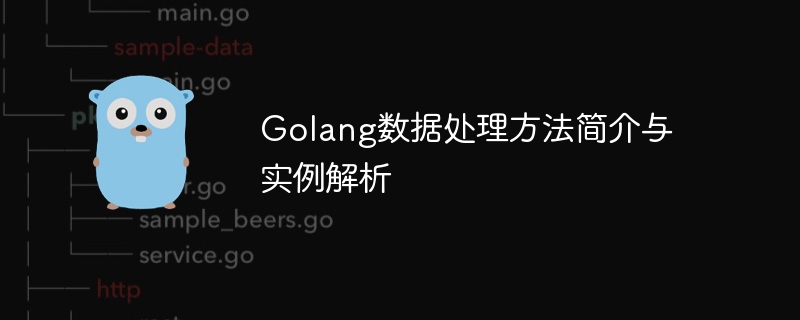Home >Backend Development >Golang >Introducing Golang data processing methods and example analysis
Introducing Golang data processing methods and example analysis
- WBOYWBOYWBOYWBOYWBOYWBOYWBOYWBOYWBOYWBOYWBOYWBOYWBOriginal
- 2024-02-19 12:08:22954browse

Golang is a fast, efficient, and concise programming language. Its excellent concurrent processing capabilities and rich data processing methods make it widely used in the field of data processing. This article will introduce some commonly used data processing methods in Golang and analyze their use in detail through examples.
1. Slice
Slice is one of the commonly used data structures in Golang and can be dynamically grown or reduced. Through slicing, we can easily operate on data. The following is a simple slicing example:
package main
import "fmt"
func main() {
nums := []int{1, 2, 3, 4, 5}
// 添加元素
nums = append(nums, 6)
// 删除元素
nums = append(nums[:2], nums[3:]...)
fmt.Println(nums)
} In the above code, an integer slice containing 1 to 5 is defined, and then a new element 6 is added through the append method, and then passed The slicing operation removes the element with index 2. The result after running is [1 2 4 5 6].
2. Map
The map in Golang is similar to the hash table in other languages, used to store key-value pairs. Mappings make it easy to store and retrieve data. The following is a simple mapping example:
package main
import "fmt"
func main() {
m := make(map[string]int)
m["a"] = 1
m["b"] = 2
fmt.Println(m)
fmt.Println("The value of key 'a' is:", m["a"])
}In the above code, a mapping m is defined, which stores string keys and integer values. An empty map is created through the make function, and then the index operator [] is used to store and access key-value pairs. The result after running is map[a:1 b:2], and The value of key 'a' is: 1.
3. Concurrency
Golang is famous for its excellent concurrency processing capabilities. Concurrent processing can be easily achieved using goroutines and channels. The following is a simple example of concurrent processing:
package main
import (
"fmt"
"time"
)
func calculateSum(s []int, ch chan int) {
sum := 0
for _, v := range s {
sum += v
}
ch <- sum
}
func main() {
nums := []int{1, 2, 3, 4, 5}
ch := make(chan int)
go calculateSum(nums[:len(nums)/2], ch)
go calculateSum(nums[len(nums)/2:], ch)
sum1, sum2 := <-ch, <-ch
finalSum := sum1 + sum2
fmt.Println("The sum of the numbers is:", finalSum)
} In the above code, a function calculateSum is defined to calculate the sum of slice elements, and concurrent calculation is implemented through goroutine and channel. In the main function, divide the slice into two parts and pass them into two goroutine calculations respectively, and obtain the final sum after receiving the results. After running, the calculated sum will be printed.
Through the above examples, we can see the flexibility and efficiency of Golang in data processing. These characteristics make it an ideal choice for processing large-scale data. Hope this article can be helpful to readers.
The above is the detailed content of Introducing Golang data processing methods and example analysis. For more information, please follow other related articles on the PHP Chinese website!

